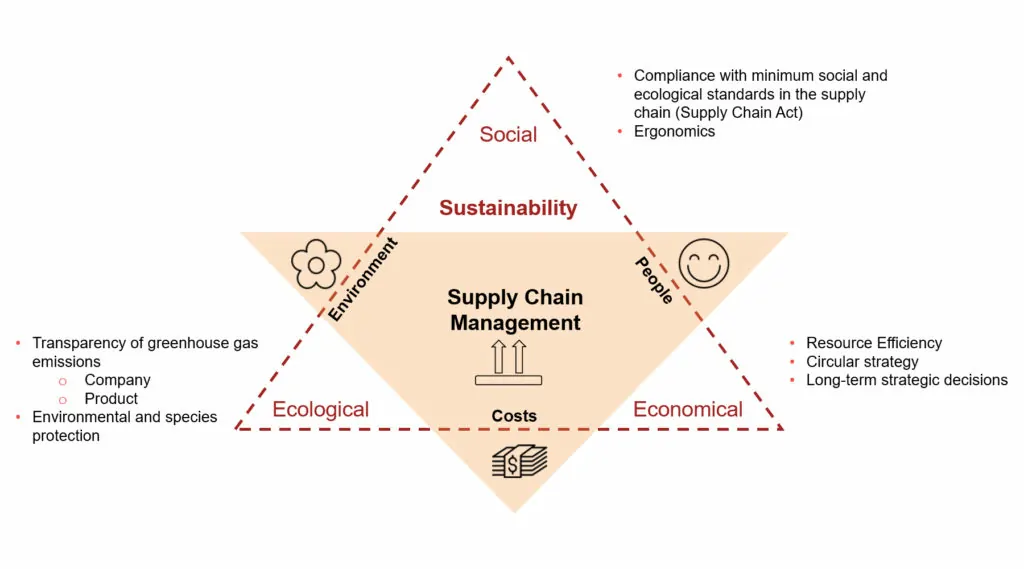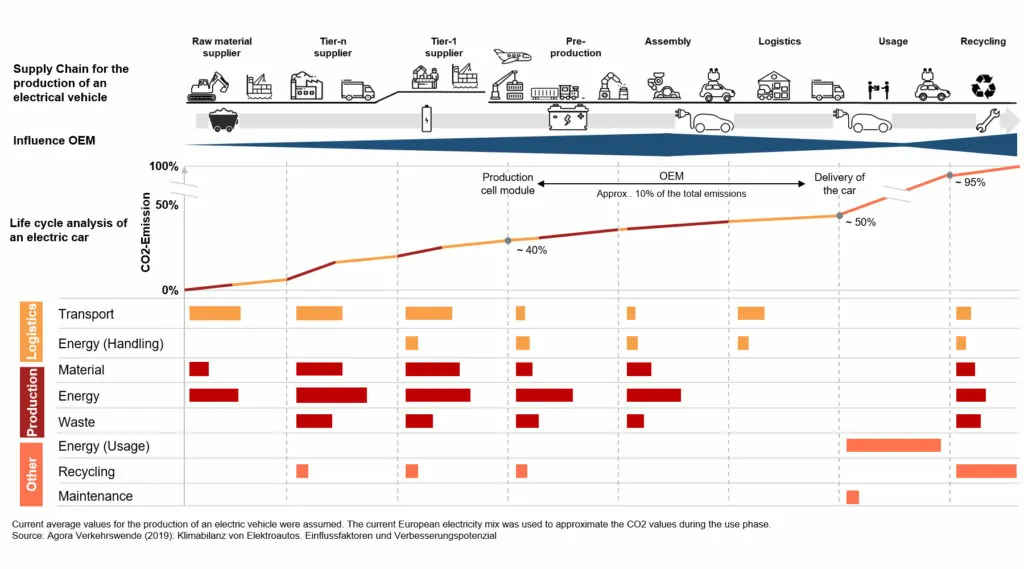Sustainability in Supply Chain Management
December 17, 2020

December 17, 2020

Marco Fuhr has been on the logistics management team at valantic since 2017. Together with his colleague Philipp Grittner, he started to establish the topic of sustainability at the company in 2019. The focus was especially on the question of how we can create a sustainable environment for valantic and how valantic can support its customers in this transformation. valantic’s sustainability team has identified several approaches in supply chain management that are very urgent.
Currently, there are few topics that are being discussed as controversially as sustainability. But how, precisely, do you define sustainability?
That’s a very good question, since frequently in the discussion, the focus is on just a few individual aspects. In my opinion, a very appropriate definition of sustainable action is to handle what resources you have so that there will be no negative effects for the future. A very current example of this is climate change. Our handling of the resources we have has exceeded our planet’s ability to regenerate them since the Industrial Revolution. Accordingly, our behavior today means that we will not leave future generations the same prerequisites we had. In addition to climate change, however, aspects such as the conservation of nature and species also plays a role in ecological sustainability.
Alongside the ecological component, sustainability includes economic and social aspects which, all together, form the sustainability triangle. This “triple bottom line” approach assumes that sustainable development can only be achieved if all three components are considered equally. Doing business in an ecologically sustainable manner means, in addition to the efficient use of resources, also orienting ourselves according to the strategy of long-term goals and not thinking for the short term about maximizing shareholder value, for example. Along with fighting poverty, social sustainability includes the equal distribution of resources and opportunities. Using the transfer of this sustainability triangle to the target function in supply chain management (SCM), the complexity of the topic becomes clear. Sustainable supply chain management always has to consider in its goals economics (costs), ecology (environment), and social factors (people).

How can this general definition of sustainability be transferred to companies and why should companies stop to consider the topic of sustainability?
Sustainable action is not just a topic for each individual person, it’s a social topic. Accordingly, policy is currently responsible for orienting the basic conditions according to the sustainable development goals of the United Nations. With regard to environmental protection, through regulations (e.g. CO2 pricing) and subsidy programs, policy provides concrete incentives for companies to do business sustainably.
In addition to policy, other stakeholders also increase the pressure on companies:
Through these many influences on companies, I believe that sustainability efforts in Germany will increase drastically in the years to come.
Your consulting focus is on supply chain management. What sustainability topics do you see as most urgent in the supply chain?
If a company wants to become more sustainable, it should think initially about how it defines sustainability and which topics should be foremost for the company. Here, depending on the corporate structure, ecological, social or economic factors in the supply chain can be the focus.
Economic sustainability is the area of sustainability that has made the most progress. For years, companies have been trying to use resources efficiently, increase the recycling quota, and avoid creating garbage. Precisely here there is great potential for supply chain management; for example, by implementing a circular approach along the entire supply chain and the life cycle.
With regard to social sustainability, there is currently a controversial supply chain law under discussion. This law would obligate companies that are headquartered in Germany to ensure ecological and social minimum standards along the entire supply chain, on down to raw material suppliers. This requirement being discussed forces companies to consider their own supply chains more closely. Examples of non-adherence to sustainable minimum standards can be found, among others, in the textile industry (economic exploitation and non-adherence to social minimum standards in individual countries) and the automobile industry (adherence to standards for labor and human rights with regard to the disposal of problematic raw materials such as cobalt in Africa). These examples show how much work some companies have to do to catch up with respect to sustainability and how great the damage to companies’ image can be in case of scandals.
When it comes to ecological sustainability, every company’s first step should be to demand transparency about the current environmental effects of its business processes. A very widespread possibility for greater transparency is the creation of the product or corporate carbon footprint, which measures the amount of greenhouse gases that a product or company generates. As soon as this climate balance sheet has been created, the largest drivers and measures for reducing greenhouse gases can be defined and implemented. In the course of establishing our service portfolio, for example, we were able to determine how large the CO2 footprint of a battery-driven vehicle is across its entire life cycle and where the greatest drivers for greenhouse gas emissions lie.

You have focused on the topic of sustainability at valantic since 2019. How did this come about and what are you working on now?
At the start of 2019, my colleague Philipp Grittner and I began to think in detail about the topic of sustainability. This is also an important topic in our private lives, which is why we were able to apply our knowledge here very well. We wanted to check the extent to which we as valantic could incorporate sustainability topics into our portfolio. In the process, the management supported us from the very beginning and granted us a lot of freedom.
After we had formulated some interesting topics and at the same time analyzed the sustainability of our own company, we presented our results to the management team at the beginning of 2020. We received the support we had hoped for and started an initiative within valantic. In the meantime, the sustainability team includes twelve colleagues who work in a variety of positions at valantic.
On the one hand, we focus on valantic-internal topics such as resource efficiency in our office and business processes; sustainability and social projects; and effects of remote work on our projects and employees. At the same time, we were able to create a climate balance sheet for our valantic office in Munich for the year 2019; it enables us to measure emissions of greenhouse gases and take measures to reduce these.
On the other hand, we examined external topics, which focused on the question of how we can help our customers become more sustainable. For this, we examined expansions to and the emphases of our service portfolio on sustainability, such as the creation of transparency about environmental effects; the implementation of measures for resource efficiency and productivity increase; and changes in the automobile industry thanks to sustainable trends.
What were the most important insights for you? What do companies have to consider for their sustainability transformation?
In my opinion, the most important step on the path to becoming a sustainable company is to take the first step. The strategy does not always have to be specified down to the last detail. Much more important is that the changes and developments are credible and palpable for employees and other stakeholders. A sustainability transformation cannot succeed if the strategy is defined by management. Instead, sustainability has to be anchored in the values of a company and the individual employees. Accordingly, the focus is on the core components change management and the encouragement of internal initiatives. Here, what seem like small changes in employees’ everyday lives can have a big effect and make a sustainability transformation something that employees really experience.
Another important point is creating transparency and making success measurable. We succeeded in doing this with the creation of the corporate carbon footprint for our valantic location in Munich. On this basis, we can make the success of measures already taken, for example, the new mobility concept or the move into an energy-efficient office building, directly measurable. The company’s climate balance sheet also enables us to identify the biggest drivers of our greenhouse gas emissions and to take measures to counteract these. One crucial aspect companies must consider for their sustainability transformation is the implementation of sustainability metrics, enabling them to track progress, identify areas for improvement, and demonstrate accountability
Especially when it comes to our focal point supply chain management, I believe it’s crucial not to focus just on one side of things; you always have to find an ecologically and economically sensible solution that is also socially sustainable.
Thank you very much for the conversation, Marco!
Don't miss a thing.
Subscribe to our latest blog articles.